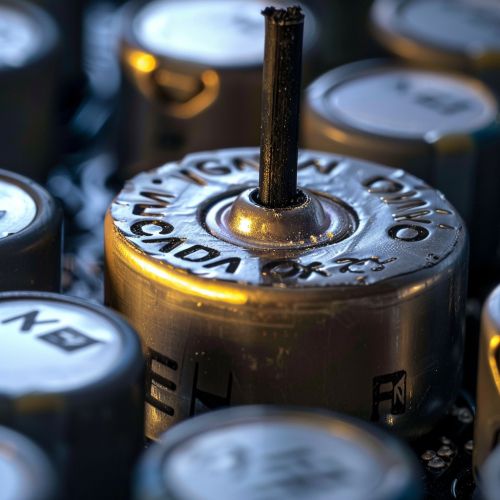Zinc–carbon battery: Difference between revisions
No edit summary |
No edit summary |
||
| Line 75: | Line 75: | ||
* [[Rechargeable battery]] | * [[Rechargeable battery]] | ||
[[Image:Detail-79279.jpg|thumb|center|Close-up photo of a zinc–carbon battery showing the zinc casing and carbon rod.]] | [[Image:Detail-79279.jpg|thumb|center|Close-up photo of a zinc–carbon battery showing the zinc casing and carbon rod.|class=only_on_mobile]] | ||
[[Image:Detail-79280.jpg|thumb|center|Close-up photo of a zinc–carbon battery showing the zinc casing and carbon rod.|class=only_on_desktop]] | |||
== Categories == | == Categories == | ||
Latest revision as of 21:17, 17 May 2024
Introduction
A zinc–carbon battery is a type of primary cell battery that has been widely used for over a century. It is a dry cell battery that uses zinc and manganese dioxide as electrodes, with an acidic electrolyte. These batteries are commonly found in everyday household items such as flashlights, remote controls, and toys. Despite the advent of more advanced battery technologies, zinc–carbon batteries remain popular due to their low cost and reliability.
History
The zinc–carbon battery was developed in the late 19th century by Georges Leclanché, a French engineer. Leclanché's original design, known as the Leclanché cell, used a liquid electrolyte. This design was later improved by Carl Gassner, who created the first dry cell version in 1886. The dry cell design eliminated the need for a liquid electrolyte, making the battery more portable and less prone to leakage.
Chemical Composition and Reactions
Anode
The anode of a zinc–carbon battery is made of zinc, which serves as both the container and the negative terminal. The zinc undergoes oxidation during the discharge process, releasing electrons.
Cathode
The cathode is composed of manganese dioxide mixed with carbon powder. The manganese dioxide acts as the depolarizer, while the carbon powder increases the conductivity of the cathode.
Electrolyte
The electrolyte is typically a paste of ammonium chloride or zinc chloride. This paste facilitates the flow of ions between the anode and cathode, enabling the electrochemical reactions that generate electricity.
Electrochemical Reactions
The overall reaction in a zinc–carbon battery can be summarized as follows: \[ \text{Zn} + 2 \text{MnO}_2 + 2 \text{NH}_4\text{Cl} \rightarrow \text{Zn(NH}_3\text{)}_2\text{Cl}_2 + \text{Mn}_2\text{O}_3 + \text{H}_2\text{O} \]
At the anode, the zinc undergoes oxidation: \[ \text{Zn} \rightarrow \text{Zn}^{2+} + 2 \text{e}^- \]
At the cathode, the manganese dioxide undergoes reduction: \[ 2 \text{MnO}_2 + 2 \text{NH}_4^+ + 2 \text{e}^- \rightarrow \text{Mn}_2\text{O}_3 + 2 \text{NH}_3 + \text{H}_2\text{O} \]
Types of Zinc–Carbon Batteries
Standard Zinc–Carbon Batteries
These are the most common type, used in a variety of household applications. They are characterized by their low cost and moderate energy density.
Heavy-Duty Zinc–Carbon Batteries
Heavy-duty versions use zinc chloride as the electrolyte instead of ammonium chloride. This results in improved performance, particularly in high-drain applications.
Applications
Zinc–carbon batteries are used in a wide range of applications due to their low cost and availability. Common uses include:
- Flashlights
- Remote controls
- Toys
- Clocks
- Portable radios
Advantages and Disadvantages
Advantages
- Low cost
- Wide availability
- Simple and reliable design
- Suitable for low-drain applications
Disadvantages
- Lower energy density compared to alkaline and lithium batteries
- Limited shelf life
- Prone to leakage over time
- Poor performance in high-drain applications
Environmental Impact
Zinc–carbon batteries contain materials that can be harmful to the environment if not disposed of properly. The zinc and manganese dioxide can contaminate soil and water, while the ammonium chloride or zinc chloride electrolyte can be corrosive. Proper recycling and disposal methods are essential to minimize environmental impact.
Future Prospects
While zinc–carbon batteries are being gradually replaced by more advanced technologies such as alkaline batteries and lithium-ion batteries, they still hold a niche market due to their low cost and simplicity. Research is ongoing to improve their performance and environmental impact, potentially extending their relevance in the future.
See Also


